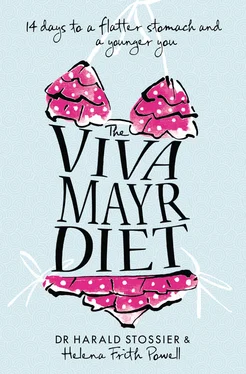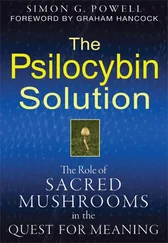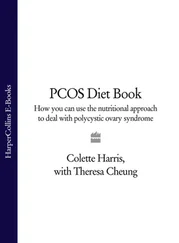This is not a difficult diet in terms of what you eat, and you most certainly won’t be horribly hungry, so throw yourself right into it. There are a few adjustments to your routine that will have to be made, such as eating a big breakfast and having dinner earlier in the evening. Start this diet with an open mind, and for 14 days I’ll guide you through the ins and outs of the optimum way to eat.
Once you have been shopping, have a quiet night and end the evening with a cup of hot water, or herbal tea such as lemon balm, chamomile, or St John’s wort. If you wish, add a slice of lemon. You need to begin to cleanse your system in preparation for the new you. Tomorrow is a big day.
• Preparing yourself emotionally, physically and practically will help to ensure your Viva Mayr experience is a success.
• Spelt bread is an essential on the diet, and making it can be a therapeutic experience, not to mention great practice for chewing properly.
• Make sure you have all the right foods at your fingertips as this will help to get you through periods where you run out of steam.
Sally, 49, London
I have four boys, and have basically been overweight since the birth of the first one. Then things just got worse. I have been on more crazy diets than you can imagine. One involved nothing but celery (the idea being that you use more calories chewing it than you consume), and another involved eating nothing but boiled eggs and grapefruit. I was starving hungry all the time, and had to cook scrummy food like macaroni cheese for the children, which just added to my misery. As soon as I heard about Viva Mayr I thought I would try it because it sounded more realistic than anything else I had tried. I also realised there was no need to torture myself with cooking for the children, because they could just eat what I did and so could my husband.
I started on a weekend. The children and I made the spelt bread, and we stocked up on all the food. Actually, it was a bit of an adventure – a challenge – and we all got into it. They didn’t like the spelt bread, but I did. I also tried to get them all to chew slowly, which with four boys was not easy. I have stuck to the diet and am steadily losing weight. I feel a lot better, too, mainly because I am finally doing something constructive about the state of my body – something that I feel is more sustainable and long-term than anything I tried before.
You are about to discover:
How to eat the Viva Mayr way
How to prepare yourself mentally for the Viva Mayr Diet
The good foods with which you can now fill your kitchen
How to put the famous Viva Mayr spelt bread to good use
Green tea, spelt bread, and fresh vegetable sticks with herbal spread (see here)
Leafy salad with walnuts, apples and linseed dressing, and potato and vegetable gratin with spinach sauce (see here)
Poached trout with vegetables and lemongrass (see here)
By the time you’ve finished this chapter and inwardly ‘digested’ all of the information it contains, you will have the tools you need to change your eating habits for life. This is not a complicated process. Even I managed it and I have spent most of my life just eating whatever happens to come my way. I am not the kind of person who really thinks about what I am putting into my body. Until now, that is. Meeting Dr Stossier has made me realise that leaving my body’s nutrition to fate or convenience – or whatever you like to call it – is close to criminal. How can I expect my body and face to stay healthy and young if I don’t even feed it properly?
Although the Viva Mayr Diet is very much focused on how we eat (which we will deal with in the subsequent chapters), before you can think about that, you need to decide what to eat.
This is where good digestion begins and, as good digestion equals slimness, youthful looks and a healthy lifestyle, it’s extremely important. We are all masters of what we put in our mouths. In other words, we all have choices. No one is force-feeding us. As Dr Stossier puts it; ‘If you want to go down the junk food route, then that’s your decision. If you decide to opt for a healthier life that’s your decision, too.’ And we both know which one he would prefer us to choose.
Years ago, one nutritionist said to me that ‘healthy eating begins in the supermarket’. Pretty basic, but something we tend to ignore as we pop a few ‘treats’ into the trolley. We all have our weak points. I have a total thing for shortbread biscuits, which I obviously don’t tell Dr Stossier about, for fear of being sacked before I even begin to work on his book. But as I prepare to go for a stay at his famous Viva Mayr Clinic to research this book, I wonder if I will be searched on my way in and what may be the consequences of hiding one packet of M&S Organic shortbread fingers in my luggage. They are organic, after all.
Food provides our bodies with nutrition. Different foods provide the body with the substances it needs to live; in other words, they convey life. In order for them to give us life and health, they need to contain nutrients as well as their life force and vitality. These nutrients are defined by the quality of the food we choose to eat. So what should we be eating? Probably not shortbread biscuits. Even organic ones.
Our nutrition is divided into three groups: proteins, carbohydrates and fats. I have heard this countless times, but have no idea what it means or what I am supposed to do with this knowledge. I have also been told that we should be eating around 50–55 per cent carbohydrates, 15 per cent protein, and 30 per cent fat. Also important is fibre. So what does this all mean?
‘We have been told to eat more carbohydrates so that we produce energy,’ says Dr Stossier. ‘But really these guidelines are misguided. If we eat a lot of carbohydrates, the pancreas needs to produce a great deal of insulin to bring them into our cells. Insulin is required to metabolise carbs, and to use the energy with which they can provide us. So basically, when you eat a lot of carbs, your body converts them into sugars. In order to control your blood-sugar level, your body produces the hormone insulin. But if there is insulin in our bodies, it tell us, ‘there is energy – we have enough, so use it’. So our body turns any excess energy from the carbs into fat, which is effectively a ‘store’ of energy for later use. It’s not a great situation. As long as insulin levels remain high in the body, we will also store the other components of food, such as protein or fat. This has a massive influence on our weight, and affects the way that we should exercise as well (see here).
Dr Stossier suggests that we should eat about the same amount of protein but increase our intake of the right kinds of fats (making sure we make the right choices between saturated and unsaturated fatty acids; more on that later) and cut down the carbs, as well as the amount we eat overall. ‘Some people eat up to 3,700 calories or more a day,’ says Dr Stossier. ‘This would be ideal for an active sportsman training for a competition, but it is way too much for most normally active people. There is no mystery to losing weight; cut down on carbohydrates and increase your intake of unsaturated fatty acids.’
If you think about the fact that a Krispy Kreme Caramel Kreme Crunch doughnut, or its cousin the Apple Fritter, each contains almost 400 calories a pop, you’ll see how easy it is for the calories to add up. After all, who can stop at one when they sell them in handy boxes of a dozen?
Читать дальше









